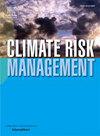实现欧洲减少野火风险的目标和目标-机遇和挑战
IF 5
2区 环境科学与生态学
Q1 ENVIRONMENTAL SCIENCES
引用次数: 0
摘要
世界范围内野火的影响正在增加。造成这些影响的根本原因是多方面的,其中包括气候变化、燃料的积累以及荒地-城市界面(WUI)定居点的增加。为了更好地了解和管理这些发展,报告和倡议已经启动,并呼吁采取更综合的野火风险管理方法,包括使用目标或关键绩效指标(kpi)。然而,尽管有葡萄牙等一些例子,欧洲仍主要缺乏野火风险管理目标。这是令人惊讶的,因为它们在美国得到了更广泛的应用,在欧洲也得到了更广泛的应用。因此,这一视角更仔细地审视了目标在减少全球不同灾害风险方面的使用情况,并反映了欧洲减少野火风险目标的机遇和挑战。最后对欧洲野火风险降低目标的应用提出了一些建议。本文章由计算机程序翻译,如有差异,请以英文原文为准。
Towards wildfire risk reduction goals and targets for Europe – Opportunities and challenges
The impact of wildfires is increasing worldwide. The root causes of these effects are manifold, encompassing among others climate change and the accumulation of fuels and increasing settlements in wildland-urban interfaces (WUI). Reports and initiatives to better understand and govern these developments have been launched and call for more integrated approaches to wildfire risk management, including the use of targets or Key Performance Indicators (KPIs).
However, despite some examples such as Portugal, wildfire risk management targets are still mainly lacking in Europe. This is surprising since they find wider application in the U.S. and are also more widely applied for flooding in Europe.
This perspective hence takes a closer look at the use of targets in reducing disaster risk for different hazards worldwide and reflects about the opportunities and challenges for wildfire risk reduction targets for Europe. It concludes with some suggestions for the application of wildfire risk reduction targets for Europe.
求助全文
通过发布文献求助,成功后即可免费获取论文全文。
去求助
来源期刊

Climate Risk Management
Earth and Planetary Sciences-Atmospheric Science
CiteScore
8.20
自引率
4.50%
发文量
76
审稿时长
30 weeks
期刊介绍:
Climate Risk Management publishes original scientific contributions, state-of-the-art reviews and reports of practical experience on the use of knowledge and information regarding the consequences of climate variability and climate change in decision and policy making on climate change responses from the near- to long-term.
The concept of climate risk management refers to activities and methods that are used by individuals, organizations, and institutions to facilitate climate-resilient decision-making. Its objective is to promote sustainable development by maximizing the beneficial impacts of climate change responses and minimizing negative impacts across the full spectrum of geographies and sectors that are potentially affected by the changing climate.
 求助内容:
求助内容: 应助结果提醒方式:
应助结果提醒方式:


